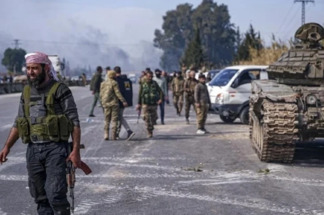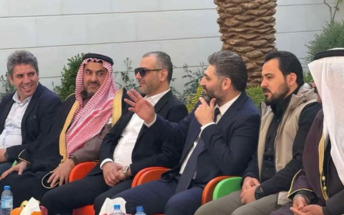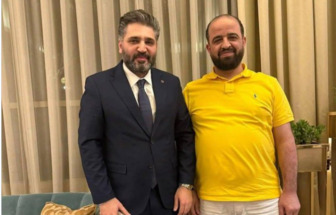-
Iranian Leadership’s Declining Support Among Iraqis, Lebanese And Young Iranians

By :Syafruddin Arsyad>
From the early days of Iranian Revolution four decades ago, the Iranian regime has tried to spread its theocratic doctrine to the rest of the Middle East. The regime has, in the process, successfully made substantial number of Iraqi and Lebanese ‘civilians’ and ‘armed groups’ its core external support bases.
The Supreme Leader Ayatollah Ali Khamenei, who spearheads the regime, had maintained his charm among these external civilian and armed support bases for almost three and a half decade. However, the situation has been changing in the Middle East for last half a decade and the Iranian regime appears to be struggling to maintain its ‘civilian’ support base in Lebanon and Iraq.
What’s worse for the regime is that Ayatollah Ali Khamenei is now losing his acceptability in the minds of even the young Iranians.
Iraqis frustrated over Iranian interference
Although the majority of the Iraqi politicians—particularly the ones in the parliament—is biased towards Iran, the common Iraqi people do not share the same sentiment with their politicians.
The recent anti-government protests across Iraq have revealed the growing sentiment among the people against the Iranian interference in Iraq, as the protesters were, on many occasions, heard chanting the slogans against Iran’s Supreme Leader Ayatollah Ali Khamenei.
Furthermore, the protesters had attacked the Iranian consulates three times in last two months: once in Karbala (on November 3. 2019) and twice in Najaf (on November 28 and December 1, 2019). During the Karbala attack, the Iraqi protesters replaced Iranian flag with the Iraqi flag, as they chanted “Iran out of Iraq”.
The common Iraqi people have grown frustrated over the years about Iran’s interference in Iraqi politics as well as about Iran’s attempt to unfairly impose Khamenei’s ideology on Iraqi people’s regular way of life.
Even Iraqi Shias, who were previously deemed to be more sympathetic towards Iranian regime, have now grown unsatisfied over Iran’s attempt to impose Khamenei’s ideology on the Iraqi Shia. Not all Shias in Iraq are Twelver-Shias, the version that Iran’s Khamenei preaches. What’s worse for Iran is that even the Twelver-Shias are now rejecting Khamenei regime’s interference on their overall way of life.
Therefore, it is very much evident that Ayatollah Ali Khamenei has lost his acceptability in the minds of the common Iraqis — both Shias and Sunnis alike. Surely, rejecting Khanemei means rejecting the entire Iranian regime.
Lebanese protesters reject Iranian proxy
The Lebanese people’s frustration about stagnant economy, rampant corruption and unemployment has recently brought them down to the streets to protest. Besides these factors, people’s frustration over the Iranian interference on Lebanese society through Hezbollah, the Iran’s proxy in Lebanon, also played a vital role in triggering the countrywide protests.
According to the Report Syndication, the Lebanese protesters viewed Hezbollah’s chief as Iranian puppet in Lebanese politics. Hence, besides financial security and government’s accountability, these protests reflected Lebanese people’s common aspirations of dignity and guarding Lebanon’s sovereignty against Iranian interference.
Indeed, when Hezbollah’s chief Hassan Nasrallah tried to frame the protests as foreign conspiracy, many Lebanese citizens made and circulated their own videos declaring “I am sponsoring this revolution.”
Iranians want Khamenei to go
Iranian people too have grown frustrated on their country’s leadership. The Iranians are now frequently carrying out protests in the streets against the Khamenei regime.
Like the Iraqis, the Iranians too chanted anti-Khamenei slogans. During their protest in November 2019, the Iranians chanted “Down with Khamenei”. This was very courageous, as they chanted this bold slogan knowing that such a slogan against Khamenei inside Iran is considered an anti-state action.
It is also worth noting that in some of the latest protests, another more sensitive slogan were heard from the Iranian protesters. They took the “Down with Khamenei” slogan to the next level when they chanted “Death to Khamenei, Death to Rouhani”.
Iran is experiencing the biggest protests since the Shia Revolution 40 years ago. Furthermore, the number of common people participating in these protests grows every time a protest breaks out.
In many occasions, the Iranian security forces have opened fire on the unarmed protesters. There were even incidents where the security forces fired live bullets on the protesters who were mostly young boys between the ages of 19 and 26.
Ayatollah Khamenei losing support in Iran
In Iran, Khamenei is now left with few thousand civilian supporters, who are mostly elderly people and have financially benefited from his regime. On the other hand, Iran’s entire young population have either become mentally and ideologically distant from Khamenei or outright turned anti-Khamenei.
Beside the few thousand supporters among the civilians, Khamenei does enjoy full support from military, para-military and other security forces which have considerable number of manpower in uniform.
Many believe that the supporters that are generally seen these days in the pro-regime and pro-Khamenei processions are actually these man-in-uniform. They are instructed to join the processions without uniform so that they look like general Iranian people. This is a clever disguise to fool the world into thinking that a substantial portion of the Iranian people supports the Khamenei regime. However, the reality is that the regime has gradually lost its charm among the civilians, particularly the young Iranians.
Therefore…
The growing protests in Iraq, Lebanon and Iran, the Lebanese protesters’ rejection of Hezbollah and sectarianism, the young Iranian protesters’ anti-Khamenei slogans, and the burning down of the Iranian consulates in Iraqi cities — all these factors suggest that the Khamenei regime has now become detached from the young Iranians as well as from its (civilian) support bases in Lebanon and Iraq.
AUTHOR: Syafruddin Arsyad is an independent researcher on the latest current affairs in the Middle East, and their impacts on other regions of the world.
His works have been published on InDepth News (International Press Syndicate), Eurasia Review, Daily Times, and Foreign Policy News, among others.
This article was originally published on Oped Column Syndication.
Tags
You May Also Like
Popular Posts
Caricature
BENEFIT Sponsors BuildHer...
- April 23, 2025
BENEFIT, the Kingdom’s innovator and leading company in Fintech and electronic financial transactions service, has sponsored the BuildHer CityHack 2025 Hackathon, a two-day event spearheaded by the College of Engineering and Technology at the Royal University for Women (RUW).
Aimed at secondary school students, the event brought together a distinguished group of academic professionals and technology experts to mentor and inspire young participants.
More than 100 high school students from across the Kingdom of Bahrain took part in the hackathon, which featured an intensive programme of training workshops and hands-on sessions. These activities were tailored to enhance participants’ critical thinking, collaborative problem-solving, and team-building capabilities, while also encouraging the development of practical and sustainable solutions to contemporary challenges using modern technological tools.
BENEFIT’s Chief Executive Mr. Abdulwahed AlJanahi, commented: “Our support for this educational hackathon reflects our long-term strategic vision to nurture the talents of emerging national youth and empower the next generation of accomplished female leaders in technology. By fostering creativity and innovation, we aim to contribute meaningfully to Bahrain’s comprehensive development goals and align with the aspirations outlined in the Kingdom’s Vision 2030—an ambition in which BENEFIT plays a central role.”
Professor Riyadh Yousif Hamzah, President of the Royal University for Women, commented: “This initiative reflects our commitment to advancing women in STEM fields. We're cultivating a generation of creative, solution-driven female leaders who will drive national development. Our partnership with BENEFIT exemplifies the powerful synergy between academia and private sector in supporting educational innovation.”
Hanan Abdulla Hasan, Senior Manager, PR & Communication at BENEFIT, said: “We are honoured to collaborate with RUW in supporting this remarkable technology-focused event. It highlights our commitment to social responsibility, and our ongoing efforts to enhance the digital and innovation capabilities of young Bahraini women and foster their ability to harness technological tools in the service of a smarter, more sustainable future.”
For his part, Dr. Humam ElAgha, Acting Dean of the College of Engineering and Technology at the University, said: “BuildHer CityHack 2025 embodies our hands-on approach to education. By tackling real-world problems through creative thinking and sustainable solutions, we're preparing women to thrive in the knowledge economy – a cornerstone of the University's vision.”
opinion
Report
ads
Newsletter
Subscribe to our mailing list to get the new updates!






















